Source
Are your paid Facebook campaigns underperforming? Wondering how you can increase conversions and get better results?
In this article, you’ll discover nine common Facebook ad mistakes and learn how to fix them to reach your goals.
The Facebook ads algorithm optimizes performance at the ad set level. For an ad set to achieve stable performance and leave the learning phase, it needs about 50 optimization events over the course of a week.
As you increase the number of ad sets in a campaign, you naturally have to spend more to optimize them all. If your total campaign budget is on the smaller side, your account may struggle to achieve the necessary optimization events in the required time frame. That can extend the learning phase and compromise performance in the long term.
To improve performance, consolidate ad sets as much as possible. Rather than creating a separate ad set for every interest or lookalike, group similar segments together in a single ad set. To optimize each ad set, aim for no more than three to five ads each.

Consider using a standard naming convention for each account level:
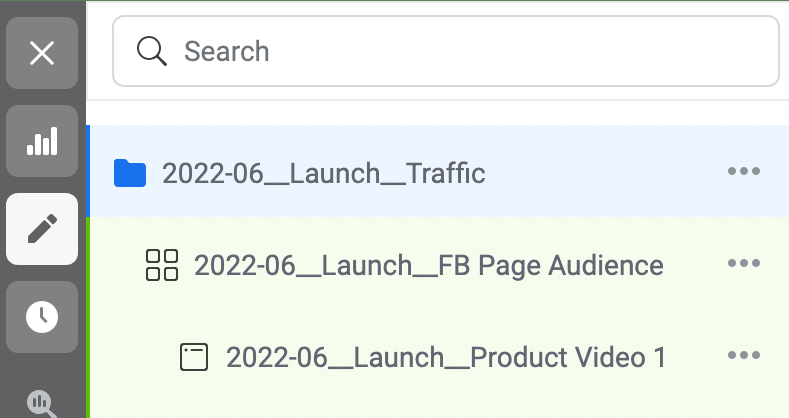
To make the naming process as easy as possible, create a template in Ads Manager. Open a campaign and click the Create Template link to the right of the campaign name. Then build a naming convention for each level of your campaign.

You can easily reuse it by switching on the Template toggle for future campaigns. That way, you can keep your account organized and easy to navigate.
But choosing the wrong objective can completely derail your campaign results. Meta’s algorithm delivers your ads to people who are most likely to complete the objective you select. If you pick traffic when you really need sales, you won’t get the results you want.
So how do you know which objective is right for your campaign?
When choosing an objective, always think about your business goal and how it aligns with the sales funnel. If you want to grow your company’s presence in a new market, choose a top-of-funnel objective. If you want to generate more revenue, choose a bottom-of-funnel objective.
The older version of Ads Manager simplifies this process by splitting objectives into funnel stages: awareness, consideration, and conversion. From the multiple objectives available for each stage, choose the one that best fits your business goal.
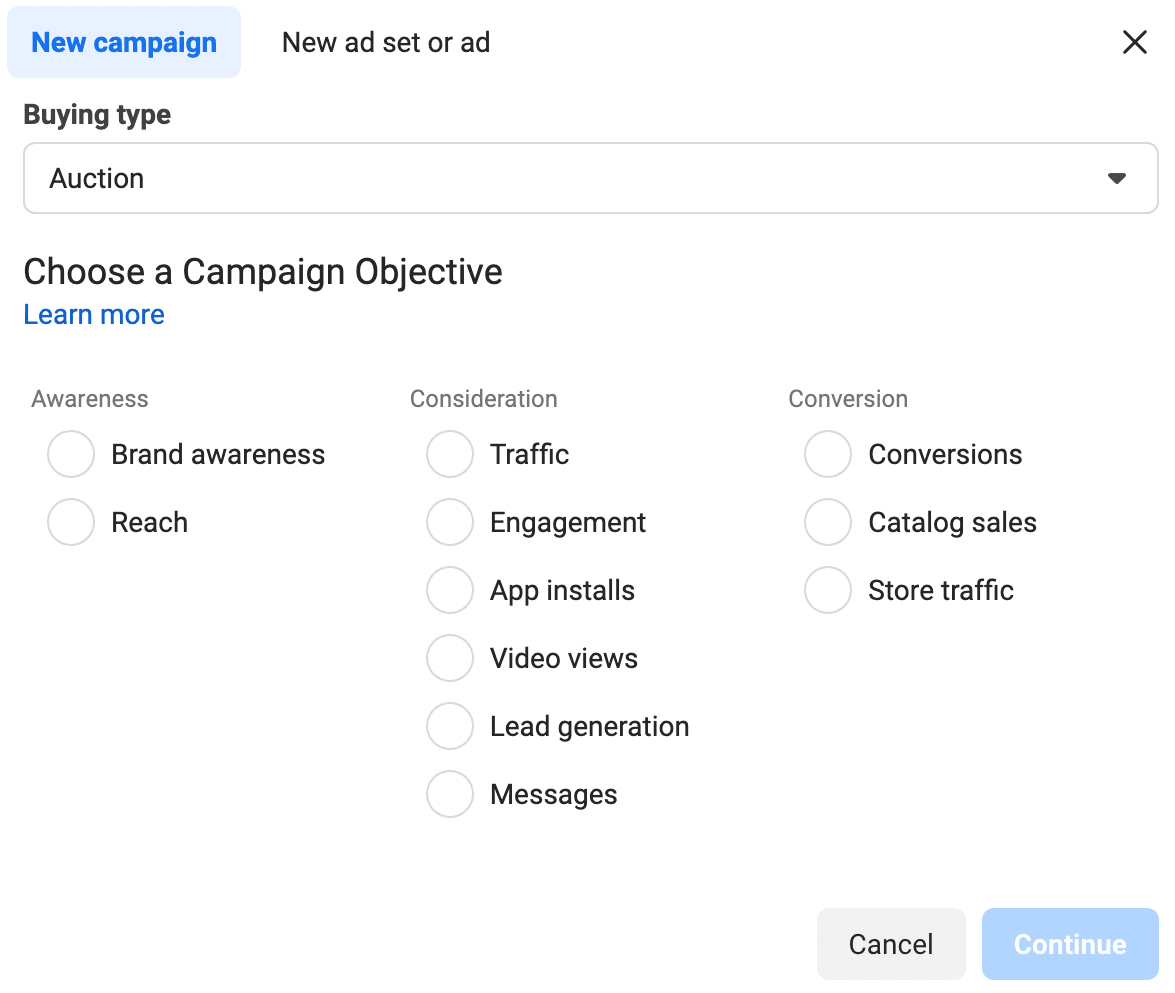
If you’re using the newer Outcome-Driven Ad Experiences (ODAX) version of Ads Manager, you can use the same thought process. Top-of-funnel objectives appear at the beginning of the list, while bottom-of-funnel goals display at the end.

In addition to picking an objective, pay attention to the optimization options at the ad set level. These options can help you fine-tune the results you want. For example, an ad set using the traffic objective can be optimized for link clicks or landing page views.
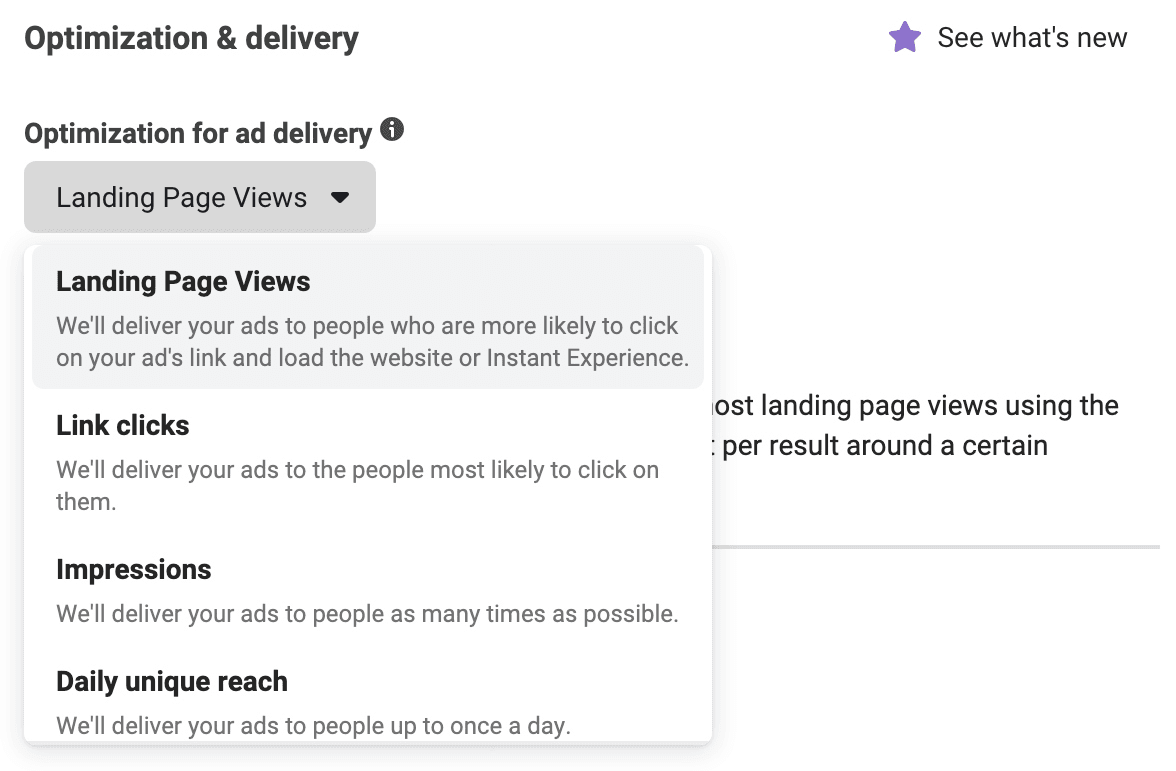
The former would result in a higher click-through rate (CTR) but visitors may not interact with your page. In contrast, the latter may result in a lower CTR but visitors may be more likely to load and interact with the page.
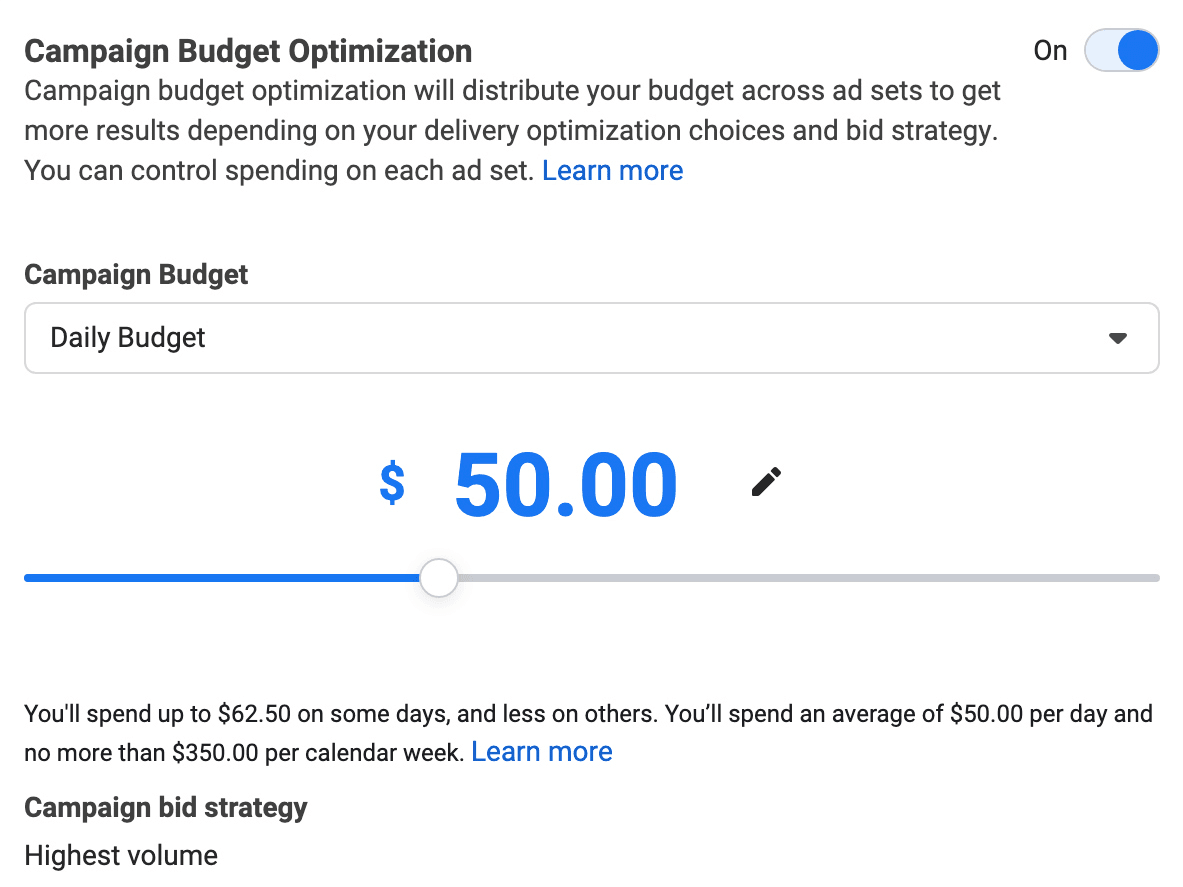
But when your campaign includes multiple ad sets with vastly different audience sizes, CBO isn’t necessarily the best choice. Using CBO can result in spending much more on large ad sets while neglecting smaller ad sets. That may mean some audience segments barely see your ads while others see them much more frequently.

To ensure that each ad set spends an appropriate amount, it’s a good idea to turn off CBO and set a budget at the ad set level instead. With an ad set budget, you have greater control over spending and ad delivery so you can get the results you want.
Since early 2021, Apple’s App Tracking Transparency framework has improved digital privacy for iOS users while limiting advertisers’ abilities to reach and track relevant users. Rather than continuing to create website-based audiences, it’s a good idea to test other targeting options.
Here are a few ideas for improving your audience targeting:

If you aren’t sure which audience is most likely to perform best, it’s a good idea to test two or more against each other. In Ads Manager, set up two ad sets that are identical aside from the audience. Then click the A/B Test button and add the ad sets to your experiment.

Choose a key metric that aligns with your campaign goal and then test the two ad sets against each other. Check back to see which ad set won, and then use what you learned to build more effective audiences.
But if you’re using these audiences for all of your campaigns, you’re neglecting your warm audiences (i.e., people who have already shown interest in your business or offer). That means you’re missing out on some critical conversion opportunities, especially when it comes to bottom-of-funnel campaigns with Conversions and Sales objectives.
So what’s the solution? To deliver your ads to people who are ready to convert, build retargeting audiences. Ads Manager gives you several options for retargeting warm audiences. You can create custom audiences using these data sources:
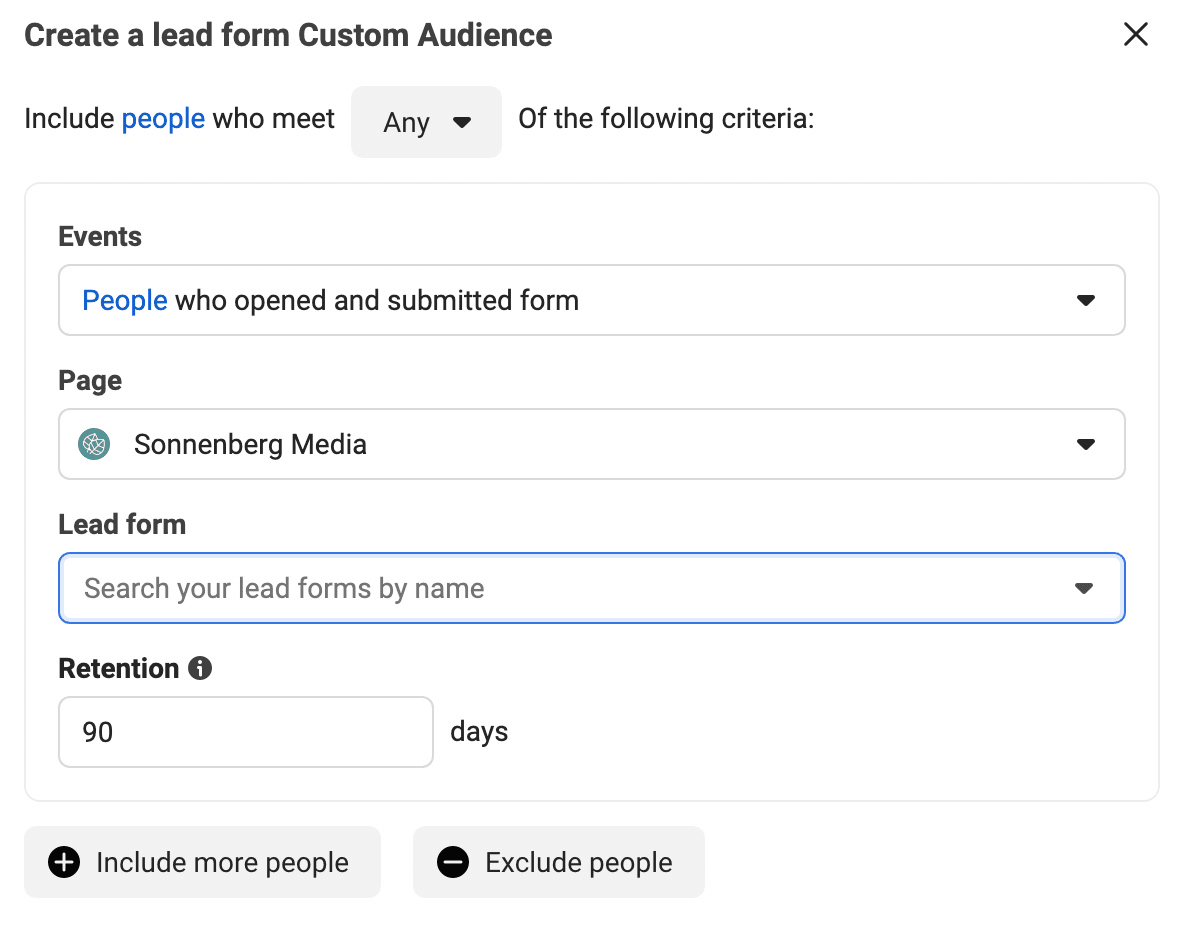
If you create a sales campaign, you can create a retargeting audience using your catalog. At the ad set level, select the Retarget Ads option and choose the criteria. You can retarget people who viewed items, added items to a cart, or purchased from a different product set.
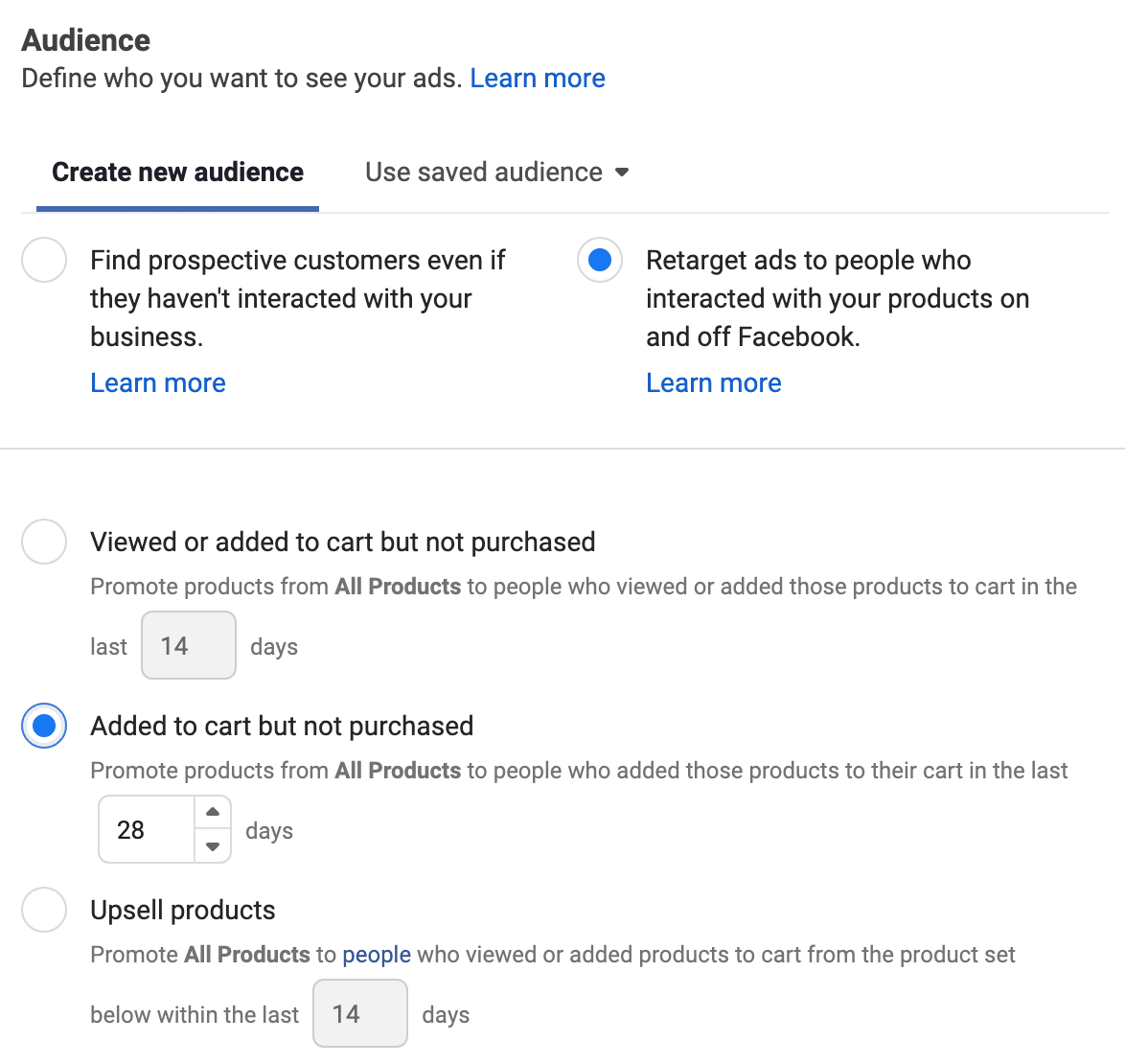
If you include multiple CTAs in the same ad, you’re likely to confuse your audience. You’re also likely to see a wider variety of suboptimal outcomes instead of getting people to complete the one high-value action you want.
Think of your CTA as a one-time opportunity to get your audience to act. Choose one CTA that reflects the main goal of your campaign. Then commit to it and reiterate your CTA in the button, ad copy, and creative.

What if you can’t choose just one CTA? In a single ad set, you can create multiple ads, each with a different CTA. You can also A/B test two or more ads against each other to find which CTA performs best.
By introducing new creatives, you can reduce ad fatigue, improve results, and decrease costs. You can also get a better sense of what your audience responds to best so you can do more of what works. Naturally, if you always create single-image ads, you’ll never know if video or carousel ads could improve results dramatically.
So how can you introduce new creatives without compromising your ad sets? Identify an ad that’s getting great results and duplicate it. Keep every aspect of the ad identical aside from the creative. Then replace it with a new image, a video, or a carousel. Compare its performance to similar ads during the same time frame to find what works best.
Alternatively, you can use Ads Manager’s A/B Test feature to compare multiple creatives. Select the ad you want to duplicate, click the A/B Test button, and opt to make a copy of the ad. For the variable, choose Creative. Run the test and watch to see which version wins so you can continue to produce effective creatives.
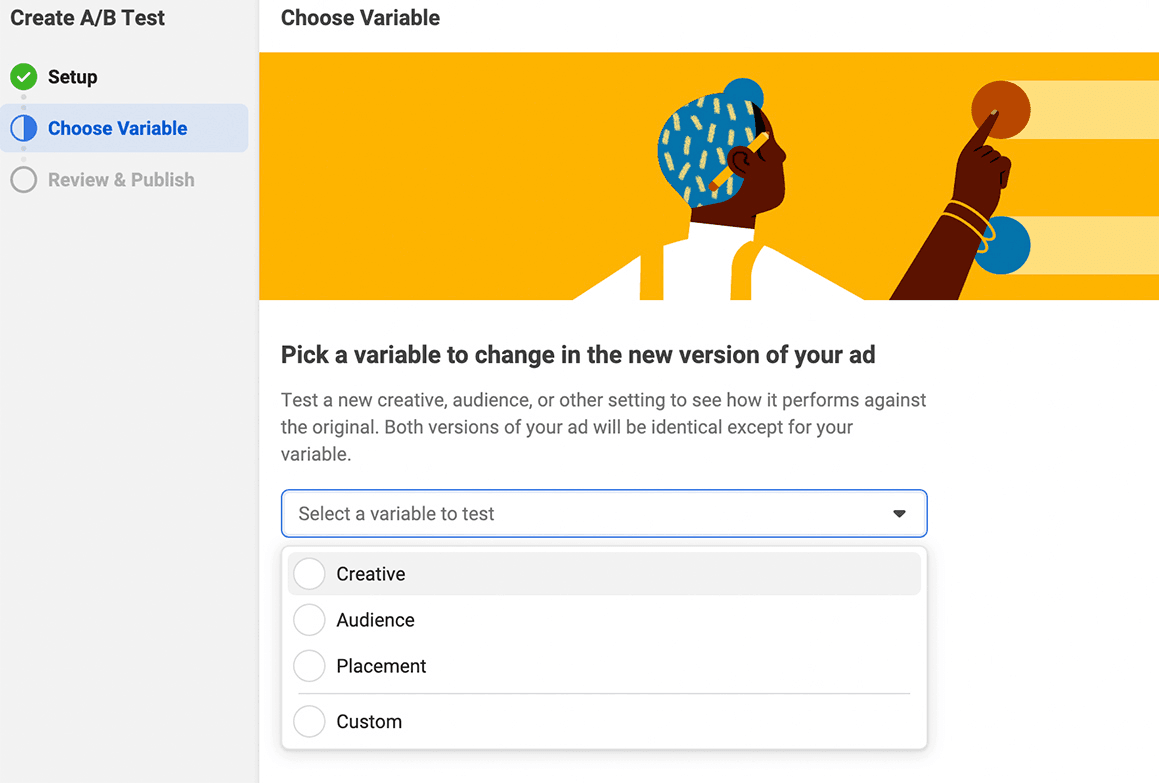
So what kind of landing page should you link to in your ad? You should almost never link to your home page, as that’s a general page without a clear purpose. Instead, you should link to a page that aligns with your campaign goals. For example, a campaign using the sales objective should link to a product page. Likewise, a campaign with the leads objective should link to an offer page.
Depending on your objective, you can also link to in-app destinations rather than external landing pages. For example, your ad can send prospects to Messenger conversations, native lead forms, or your Facebook shop.
That’s why it’s essential not to rely solely on Facebook ad reports. Fortunately, you have several options for improving accuracy and validating results:
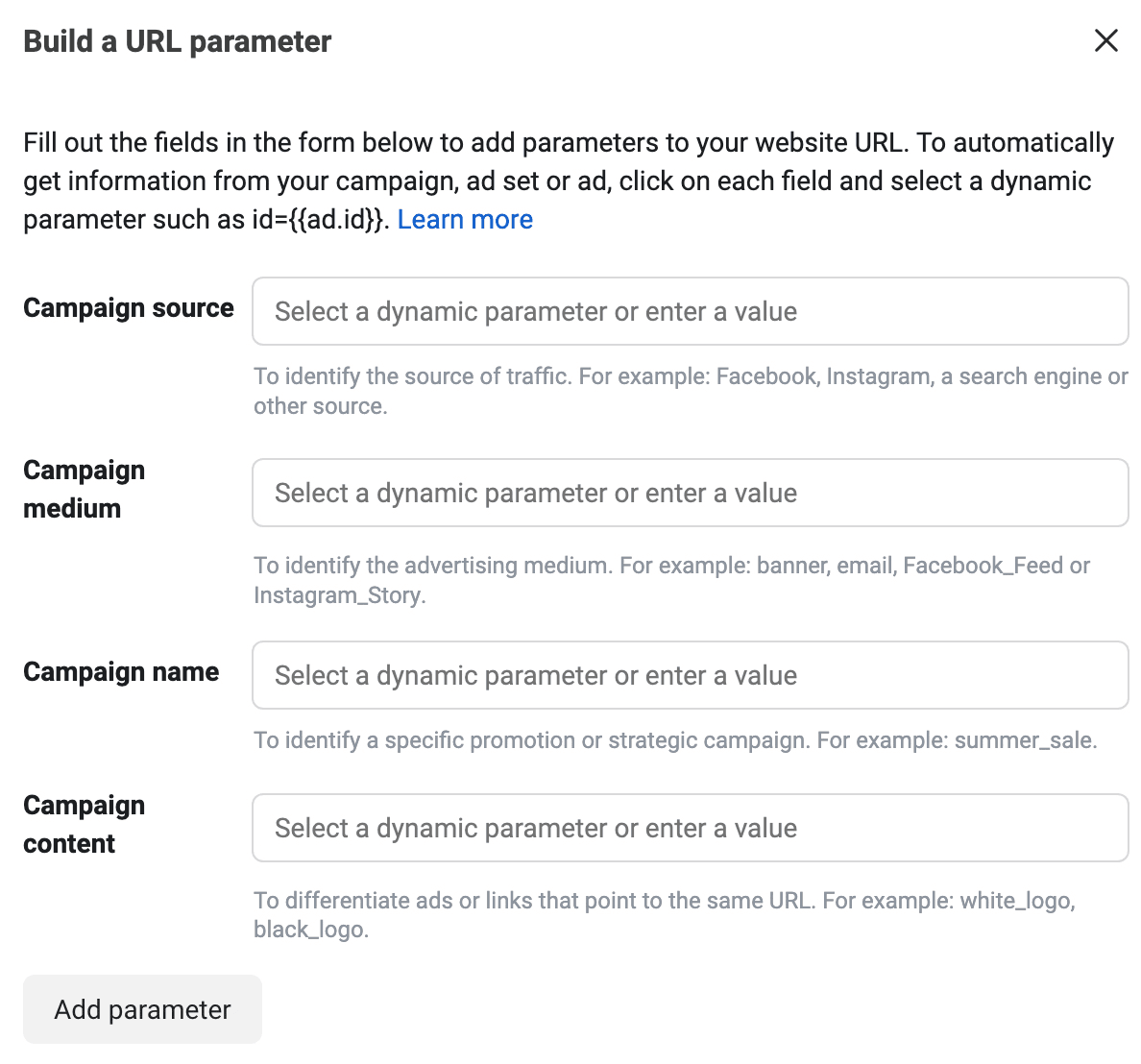
Before you create your next ad, make sure you have all of these elements in order:
Are your paid Facebook campaigns underperforming? Wondering how you can increase conversions and get better results?
In this article, you’ll discover nine common Facebook ad mistakes and learn how to fix them to reach your goals.
#1: Using an Inefficient Account Structure
Facebook Ads Manager has a built-in structure that organizes your account based on campaigns, ad sets, and ads. But if you don’t have a consistent system for building campaigns and naming elements, your ad account can quickly become disorganized and inefficient.Best Practices for Building Facebook Ad Campaigns
Each campaign needs at least one ad set and one ad. Although it’s often a good idea to create multiple ad sets and ads for each campaign, it’s important to publish only as many as necessary.The Facebook ads algorithm optimizes performance at the ad set level. For an ad set to achieve stable performance and leave the learning phase, it needs about 50 optimization events over the course of a week.
As you increase the number of ad sets in a campaign, you naturally have to spend more to optimize them all. If your total campaign budget is on the smaller side, your account may struggle to achieve the necessary optimization events in the required time frame. That can extend the learning phase and compromise performance in the long term.
To improve performance, consolidate ad sets as much as possible. Rather than creating a separate ad set for every interest or lookalike, group similar segments together in a single ad set. To optimize each ad set, aim for no more than three to five ads each.

Best Practices for Naming Facebook Ad Campaigns
Ideally, you should be able to open Ads Manager and instantly identify your campaigns’ goals, audiences, and offers. By taking a consistent approach to naming campaigns, ad sets, and ads, you can significantly increase efficiency.Consider using a standard naming convention for each account level:
- Campaign: [Date]_[Campaign Name]_[Goal]
- Ad Set: [Date]_[Campaign Name]_[Audience]
- Ad: [Date]_[Campaign Name]_[Ad Name]

To make the naming process as easy as possible, create a template in Ads Manager. Open a campaign and click the Create Template link to the right of the campaign name. Then build a naming convention for each level of your campaign.

You can easily reuse it by switching on the Template toggle for future campaigns. That way, you can keep your account organized and easy to navigate.
#2: Choosing the Wrong Objective
Even if you’re an experienced Facebook advertiser, choosing the right campaign objective can be tricky. Many of the options seem similar and some even have identical optimization settings.But choosing the wrong objective can completely derail your campaign results. Meta’s algorithm delivers your ads to people who are most likely to complete the objective you select. If you pick traffic when you really need sales, you won’t get the results you want.
So how do you know which objective is right for your campaign?
When choosing an objective, always think about your business goal and how it aligns with the sales funnel. If you want to grow your company’s presence in a new market, choose a top-of-funnel objective. If you want to generate more revenue, choose a bottom-of-funnel objective.
The older version of Ads Manager simplifies this process by splitting objectives into funnel stages: awareness, consideration, and conversion. From the multiple objectives available for each stage, choose the one that best fits your business goal.

If you’re using the newer Outcome-Driven Ad Experiences (ODAX) version of Ads Manager, you can use the same thought process. Top-of-funnel objectives appear at the beginning of the list, while bottom-of-funnel goals display at the end.

In addition to picking an objective, pay attention to the optimization options at the ad set level. These options can help you fine-tune the results you want. For example, an ad set using the traffic objective can be optimized for link clicks or landing page views.

The former would result in a higher click-through rate (CTR) but visitors may not interact with your page. In contrast, the latter may result in a lower CTR but visitors may be more likely to load and interact with the page.
#3: Picking the Wrong Budget Option
In many cases, turning on Campaign Budget Optimization (CBO) can simplify campaigns and improve results. With CBO, you don’t have to determine budgets for every ad set. Instead, you assign a budget for the campaign and allow Meta to allocate it across ad sets. If you aren’t sure how much to spend on each ad set, this option is ideal for automating the process.
But when your campaign includes multiple ad sets with vastly different audience sizes, CBO isn’t necessarily the best choice. Using CBO can result in spending much more on large ad sets while neglecting smaller ad sets. That may mean some audience segments barely see your ads while others see them much more frequently.

To ensure that each ad set spends an appropriate amount, it’s a good idea to turn off CBO and set a budget at the ad set level instead. With an ad set budget, you have greater control over spending and ad delivery so you can get the results you want.
#4: Failing to Test Audience Targeting Options
If you’ve been recycling the same Facebook ad audiences since 2021, you’ve undoubtedly struggled to maintain steady results. If your ads tend to target Facebook users who have visited your website, your results may have plummeted drastically.Since early 2021, Apple’s App Tracking Transparency framework has improved digital privacy for iOS users while limiting advertisers’ abilities to reach and track relevant users. Rather than continuing to create website-based audiences, it’s a good idea to test other targeting options.
Here are a few ideas for improving your audience targeting:
- Broad targeting: Meta recommends targeting users based on location, gender, and age to reach the widest possible group of people while optimizing ad delivery.
- Custom audiences: Build an audience based on people who have followed your Facebook page or interacted with your content to avoid iOS tracking issues.
- Lookalike audiences: Create value-based lookalike audiences based on conversion optimizations you’ve set up in Events Manager.

If you aren’t sure which audience is most likely to perform best, it’s a good idea to test two or more against each other. In Ads Manager, set up two ad sets that are identical aside from the audience. Then click the A/B Test button and add the ad sets to your experiment.

Choose a key metric that aligns with your campaign goal and then test the two ad sets against each other. Check back to see which ad set won, and then use what you learned to build more effective audiences.
#5: Neglecting Your Warm Audiences
When you build campaigns, it’s helpful to use the three-stage sales funnel framework as a guide. In other words, some campaigns may be geared toward top-of-funnel objectives and audiences. These campaigns are likely to use Reach and Awareness objectives and broad targeting, interest-based targeting, or lookalike audiences.But if you’re using these audiences for all of your campaigns, you’re neglecting your warm audiences (i.e., people who have already shown interest in your business or offer). That means you’re missing out on some critical conversion opportunities, especially when it comes to bottom-of-funnel campaigns with Conversions and Sales objectives.
So what’s the solution? To deliver your ads to people who are ready to convert, build retargeting audiences. Ads Manager gives you several options for retargeting warm audiences. You can create custom audiences using these data sources:
- Facebook or Instagram shop, including people who saved products or initiated checkouts
- Customer lists, including people you’ve added to a warm lead segment
- Videos, including people who watched certain qualifying content
- Lead forms, including people who opened and submitted your native lead form

If you create a sales campaign, you can create a retargeting audience using your catalog. At the ad set level, select the Retarget Ads option and choose the criteria. You can retarget people who viewed items, added items to a cart, or purchased from a different product set.

#6: Adding Multiple Calls to Action
Whether you’re retargeting warm leads or reaching out to new audiences, it isn’t always easy to focus on a single message. For example, you may want to encourage people to shop, prompt them to learn more about your products, and invite them to read customer reviews. Although these calls to action (CTAs) are all important, they shouldn’t appear in the same ad.If you include multiple CTAs in the same ad, you’re likely to confuse your audience. You’re also likely to see a wider variety of suboptimal outcomes instead of getting people to complete the one high-value action you want.
Think of your CTA as a one-time opportunity to get your audience to act. Choose one CTA that reflects the main goal of your campaign. Then commit to it and reiterate your CTA in the button, ad copy, and creative.

What if you can’t choose just one CTA? In a single ad set, you can create multiple ads, each with a different CTA. You can also A/B test two or more ads against each other to find which CTA performs best.
#7: Reusing the Same Old Creative Formats
If you’ve been using the same creatives for weeks or months on end, you’ve probably noticed a decrease in results or an increase in costs. That’s because delivering the same creatives over and over causes ad fatigue. Essentially, your target audience starts to ignore your ad, or worse, they hide or report it.By introducing new creatives, you can reduce ad fatigue, improve results, and decrease costs. You can also get a better sense of what your audience responds to best so you can do more of what works. Naturally, if you always create single-image ads, you’ll never know if video or carousel ads could improve results dramatically.
So how can you introduce new creatives without compromising your ad sets? Identify an ad that’s getting great results and duplicate it. Keep every aspect of the ad identical aside from the creative. Then replace it with a new image, a video, or a carousel. Compare its performance to similar ads during the same time frame to find what works best.
Alternatively, you can use Ads Manager’s A/B Test feature to compare multiple creatives. Select the ad you want to duplicate, click the A/B Test button, and opt to make a copy of the ad. For the variable, choose Creative. Run the test and watch to see which version wins so you can continue to produce effective creatives.

#8: Linking to the Wrong Destination
In most cases, you want people to do more than just see your ad. You also want them to click through to read an article, download a resource, or buy a product. If you send them to a landing page that isn’t optimal, you risk confusing people and missing out on conversions.So what kind of landing page should you link to in your ad? You should almost never link to your home page, as that’s a general page without a clear purpose. Instead, you should link to a page that aligns with your campaign goals. For example, a campaign using the sales objective should link to a product page. Likewise, a campaign with the leads objective should link to an offer page.
Depending on your objective, you can also link to in-app destinations rather than external landing pages. For example, your ad can send prospects to Messenger conversations, native lead forms, or your Facebook shop.
#9: Relying on Inaccurate Tracking Data
If you’ve noticed delayed analytics and underreported results from your Facebook ads, you aren’t alone. Ever since Apple rolled out its App Tracking Transparency framework, Facebook ad reports have become slower and less reliable.That’s why it’s essential not to rely solely on Facebook ad reports. Fortunately, you have several options for improving accuracy and validating results:
- UTM parameters: Add data to landing page URLs to track campaign activity in your web analytics tool. You can build UTM parameters at the ad level in Ads Manager.

- Events Manager: Create up to eight conversions to use as optimization events in your campaigns. Prioritize them to ensure that you track high-priority events correctly.
- First-party data: Compare the results you see in Ads Manager to the data in your eCommerce platform or web analytics tool to validate your ad reports.
- Conversions API: Establish a more direct connection between Ads Manager and your website or CRM. Installing the Conversions API can optimize ad delivery and lead to more reliable results.
Conclusion
Mapping out a comprehensive Facebook ad strategy may sound like a lot of work, but without a clear plan, you’ll end up with vague goals and undefined metrics. As a result, you’ll waste time and money, and have no idea if you’re really making progress.Before you create your next ad, make sure you have all of these elements in order:
- Account structure that’s logical and efficient so you can find campaigns and ads easily
- Objectives that align with your company’s business goals for every campaign
- Target audiences that fit with the funnel stage and ad creative
- Ad creatives that appeal to your target audience and position your offer effectively
- Landing pages that align with your offer and are optimized for your audience
- Metrics that match your objective and allow you to track progress



